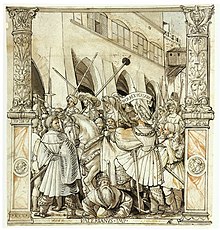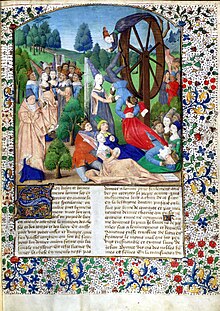Fortuna
She might bring good or bad luck: she could be represented as veiled and blind, as in modern depictions of Lady Justice, except that Fortuna does not hold a balance.She was also a goddess of fate: as Atrox Fortuna, she claimed the young lives of the princeps Augustus' grandsons Gaius and Lucius, prospective heirs to the Empire.[12] An oracle at the Temple of Fortuna Primigena in Praeneste used a form of divination in which a small boy picked out one of various futures that were written on oak rods.[13] She is functionally related to the god Bonus Eventus,[14] who is often represented as her counterpart: both appear on amulets and intaglio engraved gems across the Roman world.Modest estate has longer life; then happy he whoe'er, content with the common lot, with safe breeze hugs the shore, and, fearing to trust his skiff to the wider sea, with unambitious oar keeps close to land.[19]Ovid's description is typical of Roman representations: in a letter from exile[20] he reflects ruefully on the "goddess who admits by her unsteady wheel her own fickleness; she always has its apex beneath her swaying foot."[22] In the 6th century, the Consolation of Philosophy, by statesman and philosopher Boethius, written while he faced execution, reflected the Christian theology of casus, that the apparently random and often ruinous turns of Fortune's Wheel are in fact both inevitable and providential, that even the most coincidental events are part of God's hidden plan which one should not resist or try to change.The Christianized Lady Fortune is not autonomous: illustrations for Boccaccio's Remedii show Fortuna enthroned in a triumphal car with reins that lead to heaven.[27] In astrology, the term Pars Fortuna represents a mathematical point in the zodiac derived by the longitudinal positions of the Sun, Moon and Ascendant (Rising sign) in the birth chart of an individual.Al-Biruni (973 – 1048), an 11th-century mathematician, astronomer, and scholar, who was the greatest proponent of this system of prediction, listed a total of 97 Arabic Parts, which were widely used for astrological consultations.






Fortuna (disambiguation)CornucopiaWreathpersonificationRoman religionBoethiusRenaissancegubernaculumRota FortunaeCiceroLady JusticeprincepsAugustusLuciusCarmina BuranaGlückstadtJupiterServius TulliusAncus MarciusTrastevereEtruscanEtruscan warsForum BoariumMater MatutaSant'OmobonoPraenesteQuirinalisPorta CollinavirtusSallustCatilinespirit of measure and equityoracleTemple of Fortuna PrimigenaHouse of MenanderPompeiiBonus Eventusamuletsengraved gemsRoman RepublicCoriolanusRoman senateCastlecaryScotlandHunterian MuseumGlasgowWheel of FortuneSenecaAgamemnonAusterEmperor ValerianShapur I of PersiaEuropeanHans HolbeinSaint AugustineCity of GodConsolation of Philosophyinfluence of the starsBoethius's ConsolationmanuscriptsAmiensMusée des Beaux-Arts de StrasbourgLe Roman de la RoseVirgilBoccaccioJohn LydgateFall of Princestriumphal carThe PrinceL'incoronazione di PoppeaShakespeareSonnet 29John Kennedy TooleA Confederacy of DuncesoccultismSatanismastrologyzodiacAscendantArabic astrologyArabian PartsAl-BiruniFortuna PrimigeniaFortuna VirilisFortuna ReduxFortuna Huiusce DieiFortune favours the boldColumn of the Goths19 FortunaFaithfulnessPlutarchAb Urbe ConditaMichele ChiaruzziEncyclopædia BritannicaCollier's New EncyclopediaThe American CyclopædiaAncient Roman religionmythologyDeitiesDii ConsentesAgenoriaAngeronaAnna PerennaApolloAuroraBellonaBona DeaCarmentaCastor and PolluxCloacinaDea DiaDīs PaterEgeriaFaunusGeniusHerculesLares FamiliaresLibertasMercuryMinervaNeptunePenatesPomonaPriapusProserpinaQuirinus